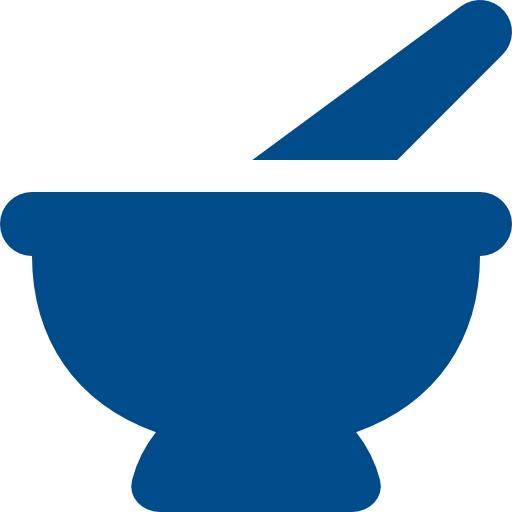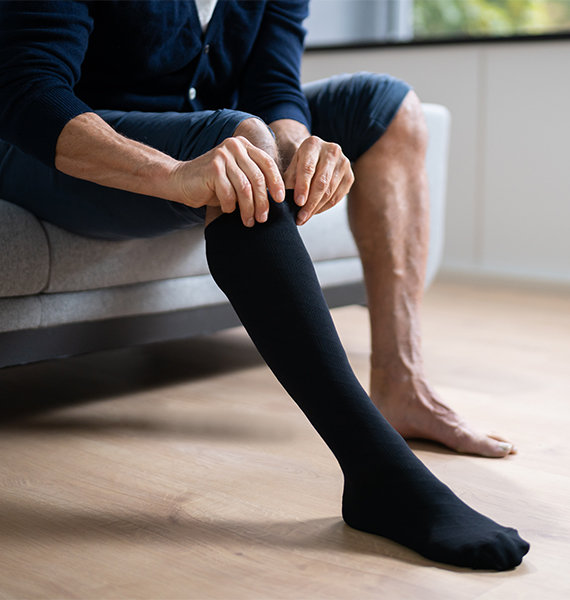
Do you struggle with poor circulation in your legs, sit most of the day, travel long distances for work, or have tired and achy feet and legs?
Then you may benefit from compression stockings! At Cook's Pharmacy, our pharmacists are here to help you learn more about medical compression stockings and selecting the right ones for you.
For help with your compression garment styles and compression stocking fitting information, visit one of our convenient pharmacy locations in Kitchener, Waterloo, Cambridge, New Hamburg, or Wellesley – or reach out to us anytime!
Talk to a Pharmacist About Compression Stockings
What Are Compression Stockings?
Compression stockings (also known as compression socks or compression hose) are snug yet stretchy socks that apply pressure to your feet, ankles, and legs to help your blood vessels work more optimally.
Depending on your unique health needs, you can purchase them over the counter or with a prescription.

How do Compression Stockings Help?
By pushing blood back towards your heart via pressure on your legs, compression stockings help your arteries relax.
When your arteries are relaxed, they can better circulate oxygen-rich blood around your body. Better blood circulation reduces your risk of blood clots, fluid pooling, swelling, discoloured skin, spider veins, varicose veins, and discomfort.
When blood flows freely, it is less likely to clot and cause many other health concerns. That is why compression stockings are often recommended to postoperative patients, bedridden individuals, pregnant women, people who sit or stand for long periods, travelers, athletes, and anyone at risk of circulation challenges.
Do you think compression socks are right for you? Ask a pharmacist at Cook’s Pharmacy today!
Who Can Benefit from Wearing Compression Stockings?
Many women and men can experience the benefits of compression socks, whether they're running or traveling, to improve their comfort level and reduce challenges from poor circulation.
Talk to your doctor or one of our pharmacists about compression stockings if:
- You are pregnant
- You have recently had surgery
- You have a family history of veinous leg disorders
- You experience challenges with circulation or varicose veins
- You have had Deep Vein Thrombosis (DVT) before
- You travel long distances
- You stand for most of the day
- You must sit or lie down for long periods
- You experience heavy, aching, and/or tired legs
- You have swollen feet, ankles, or legs
- You are an avid runner or highly active in sports
- You feel dizzy or light-headed when you stand up
Poor circulation can significantly impact your everyday comfort and, in some cases, can pose very serious or painful health risks.
Luckily, there is a very easy solution that requires limited effort! Don't delay addressing circulation challenges! Speak to an expert at Cook's Pharmacy today!
Ask a Pharmacist About Compression Stockings
Compression Stocking Styles
Many people who are new to compression stockings initially worry that their new socks will hinder their style choices or look awkward with certain apparel.
However, there are several styles of compression stockings available in various materials, patterns, colours, and thickness levels.
Whether you are seeking a discrete, neutral colour or wish to choose more vibrant patterns, you are sure to find options that suit your style and work well with your fashion choices.
Which style is right for you will also depend on your health concerns, as compression stocking are available in different cuts and lengths.
The three main styles are:
- Knee-high compression socks
- Thigh-high compression stockings
- Compression pantyhose
Knee-high compression socks range from thick, cushioned socks to ultra-thin materials. As the name implies, they slip over your foot and go up to your knee. They can be open-toe or closed-toe.
Thigh-high compression stockings are socks that go up to your thigh. Like knee-highs, they are available in different materials and open-toe or closed-toe styles. In addition, they typically have a silicone band at the top of the stocking to help it stay in place throughout the day. This style is used when full-leg compression is prescribed.
Compression pantyhose are similar to regular pantyhose in appearance and material. However, they offer varying pressure along the leg. They are most often closed-toe. In addition, they are suitable for when knee-high or thigh-high options do not offer enough coverage or would not complement your more formal attire for work or events.
Not sure which compression stocking style is right for you? Ask a pharmacist at Cook’s Pharmacy!
Ask a Pharmacist About Compression Stocking Styles
Types of Compression Stockings
There are two types of compression stockings – non-medical and medical. Generally, the only differences are in the compression strength, otherwise known as compression pressure. Medical grade compression stockings also require a prescription, while non-medical grade compression stockings are available over the counter.
Both non-medical and medical grade compression stocking pressures are measured in millimeters of mercury, or mmHg for short. This measurement indicates how well the stockings increase blood flow.
The higher the mmHg in liquids – like blood - the quicker it flows. However, higher pressure does not always mean better pressure for you in the case of compression stockings. It is more important to ensure you have the ideal pressure for your unique health concerns, and using too high of a compression level can harm you.
Understanding Compression Stocking Levels
Non-medical compression stockings typically offer 8 to 20 mmHg of compression. This level of compression is considered low. It is ideal for minor or occasional swelling or if you would like a bit of extra support while standing for much of your day. You can purchase low-compression stockings from your local pharmacy or other retailers. You do not typically require a prescription for low-compression styles.

On the other hand, medical compression stockings offer more than 20 mmHg in pressure and always require a prescription before you can purchase them. The cost of medical compression stockings is often covered under many insurance plans.
Medical compression stockings are typically available in ranges from 20 to 30 mmHg (medium compression), 30 to 40 mmHg (moderate to high compression), and 40 to 50 mmHg (firm compression).
It is important to ensure that you select the compression level that supports your unique needs. Therefore, always consult your doctor and pharmacist before purchasing any compression garment to add pressure to your feet, ankles, or legs.
Do not wear medical-grade stockings (20 mmHg or higher) without a prescription.
Which Compression Level is Right for You?
Your doctor can recommend an appropriate compression level for you, and our pharmacists can assist with general sizing and style selection.
We'll even teach you how to put them on and keep them clean!
The 20 to 30 mmHg level is considered medium compression. This style is most suited for individuals seeking to control swelling and pain. It is also often used to support patients who have experienced DVT or live with varicose veins.
30 to 40 mmHg compression stockings offer moderate to high pressure. They are best for individuals with more severe cases of pain and swelling.
40 to 50 mmHg stockings are very firm and reserved for people with a history of severe health concerns or who are at high risk of dangerous blood clots.
Ready to improve your circulation and reduce swelling and discomfort?
You are one easy step away from improving your health and well-being! Contact Cook's Pharmacy today for your compression stockings! We will help you find your perfect fit!
Ask a Pharmacist About Compression Stocking Fittings and Styles
Any medical or pharmaceutical information on this site is provided as an information resource only and is not to be used or relied on for any diagnostic or treatment purposes. This information does not create any patient-pharmacist relationship, and should not be used as a substitute for professional diagnosis and treatment.
Please consult your healthcare provider before making any healthcare decisions or for guidance about a specific medical condition.
Cook’s Pharmacy and its subsidiaries expressly disclaim responsibility and shall have no liability, for any damages, loss, injury, or liability whatsoever suffered as a result of your reliance on the information contained in this site.




